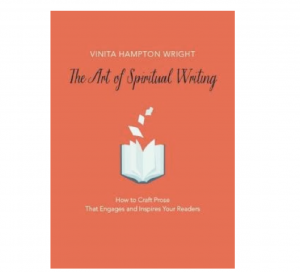The Book Whisperer: The Art of Spiritual Writing
 At Ave Maria Press, I enjoy working closely with authors to help them “develop their craft.” Rewriting and platform-building are two of the most challenging tasks for any writer, so I am always looking for helpful resources. Vinita’s new book, The Art of Spiritual Writing, is one I highly recommend for those new to the spiritual writing genre, or for authors who simply want to write with greater clarity and conviction. (For those looking for a good resource on platform building, I recommend Mike Hyatt’s Platform: Get Noticed in a Noisy World, now available on Kindle for $2.99.)
At Ave Maria Press, I enjoy working closely with authors to help them “develop their craft.” Rewriting and platform-building are two of the most challenging tasks for any writer, so I am always looking for helpful resources. Vinita’s new book, The Art of Spiritual Writing, is one I highly recommend for those new to the spiritual writing genre, or for authors who simply want to write with greater clarity and conviction. (For those looking for a good resource on platform building, I recommend Mike Hyatt’s Platform: Get Noticed in a Noisy World, now available on Kindle for $2.99.)
In The Art of Spiritual Writing, Wright articulates well the difference between “private” and “public” writing, and outlines the process that every writer needs to engage fully in order to connect with readers. She also makes it abundantly clear that the spiritual writer’s calling is different from that of a teacher or preacher — and yet there are some sobering similarities.
“The writer of the New Testament book of James warned Christians not to hanker after … teaching positions, because the responsibility was great, and when a teacher made an error, it affected many people,” Wright explains. “The same is true for writers, and especially true for writers who broach the realm of spirituality. We hanker after those book contracts and speaking engagements. But should we be so eager? Do we realize, from day to day, the power we wield when we send our words out into the world?”
Novice and veteran writers (and editors) alike will appreciate Wright’s practical advice, such as . . .
Five Things Every Spirituality Writer Needs to Know
- Nothing makes up for poor craftsmanship. “Writing is a craft, and it is a different form of expression from speaking, teaching or preaching,” Vinita observes. (I’d add that writing a book is a different form of expression from blogging, as sustaining reader interest for two hundred pages requires a different approach than getting a reader to “click through” to peruse 350 words.)
- Save teaching for the classroom and preaching for the pulpit. “You want to write so that the matter unfolds and the reader experiences the unfolding. You explore a topic, and the reader comes right along with you. … The writing itself must be seductive. … If you write in a preachy, didactic, and overbearing way, you will attract the audience you don’t want, and you’ll repel the audience you hope for.”
- Fiction is about storytelling, not teaching. “With nonfiction writing, often we are building an argument or system of thinking. The structure is probably linear, with one point leading naturally to the next.”
- The reader becomes engaged when she has to do some of the work. “Write so that the reader can imagine herself in your situation and growing right along with you. Write with balance: honest but hopeful, encouraging but challenging.”
- Personal writing must be transformed in order to work as public writing. “Many of the details that are important to you will be meaningless to readers. … Your task is to pick and choose among the thousands of details, standing back from the story to understand what a stranger would need to know and what would capture the stranger’s interest.” Later in the book, Wright points out that public writing is shaped not according to the author’s needs and preferences, but for the intended audience. “Public writing takes the concrete details of a single, personal experience to generate a discussion of the more universal experience readers will relate to.”
Speaking both as an editor and as an author who understands how difficult it can be, this fifth point is possibly the most valuable skill any writer can acquire. While there must be enough of our own story to let the reader get to know us, and learn to trust us, we need to fully engage the writing and rewriting process, so that our private thoughts are pruned and transformed into something truly life-giving.
The Art of Spiritual Writing is now available as a paperback or on Kindle, through Loyola Press or Amazon.com.

